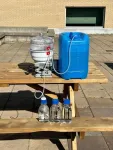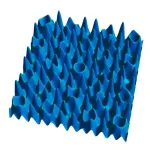(Press-News.org)
Researchers at the University of Waterloo have designed an energy-efficient device that produces drinking water from seawater using an evaporation process driven largely by the sun.
Desalination is critical for many coastal and island nations to provide access to fresh water, given water scarcity concerns due to rapid population growth and increasing global water consumption. Roughly 2.2 billion people worldwide have no access to clean water, emphasizing the urgent need for new technologies to generate fresh water, according to the UN World Water Development Report 2024.
Current desalination systems pump seawater through membranes to separate salt from water, but this process is energy-intensive, and salt often accumulates on the device’s surface, obstructing water flow and reducing efficiency. As a result, these systems require frequent maintenance and cannot operate continuously.
To solve this problem, Waterloo researchers drew inspiration from the natural water cycle to create a device that mirrors how trees transport water from roots to leaves. The new technology can continuously desalinate water without the need for major maintenance.
“Our inspiration comes from observing how nature sustains itself and the way water evaporates and condenses in the environment,” said Dr. Michael Tam, a professor in Waterloo’s Department of Chemical Engineering.
“The system we’ve engineered induces water to evaporate, transports it to the surface, and condenses it in a closed cycle, effectively preventing the accumulation of salt that reduces the efficiency of the device.”
The device is also solar-powered and can convert about 93 per cent of the sun into energy, five times better than current desalination systems. It can also produce about 20 litres of fresh water per square meter, the same amount that the World Health Organization recommends each person needs every day for basic drinking and hygiene.
The research team, which includes PhD students, Eva Wang and Weinan Zhao, made the device using nickel foam coated with a conductive polymer and thermoresponsive pollen particles. This material absorbs sunlight across the solar radiation spectrum to convert the sun’s energy into heat. A thin layer of salt water on the polymer is heated up and transported upward, similar to how water naturally travels through the capillaries in trees.
As the water evaporates, the remaining salt moves to the bottom layer of the device, like a backwash system in a swimming pool, which prevents any potential water blockage and ensures a continuous operation.
Dr. Yuning Li, a professor in Waterloo’s Department of Chemical Engineering, helped the research team generate solar energy for the project using a solar tester to measure the device’s light-harvesting properties.
“This new device is not only efficient but also portable, making it ideal for use in remote regions where access to fresh water is limited,” Li said. “This technology offers a sustainable solution to the emerging water crisis.”
Going forward, the Waterloo researchers plan to build a prototype of their device that can be deployed at sea to test the technology on a larger scale.
“If the test is proven successful, the technology can sustainably supply fresh water to coastal communities and advance UN Sustainable Development goals three, six, 10 and 12,” Tam said.
The study was recently published in Nature Communications.
END
If you were to collect all the organisms from the ocean surface down to 200 meters, you’d find that SAR11 bacteria, though invisible to the naked eye, would make up a fifth of the total biomass. These bacteria, also known as Pelagibacterales, have evolved to thrive in nutrient-poor marine environments and play a significant role in global nutrient cycles. Despite their importance, the mechanisms behind their impact on the planetary ecosystem have remained unclear.
But now, a recent Nature paper by researchers from the Okinawa ...
Physicists from the Cavendish Laboratory in Cambridge have created the first two-dimensional version of the Bose glass, a novel phase of matter that challenges statistical mechanics. The details of the study have been published in Nature.
As the name suggests, the Bose glass has some glassy properties and within it all particles are localised. This means that each particle in the system sticks to itself, not mixing with its neighbours. If coffee was localised, then when stirring milk into the coffee, the intricate pattern of black and white stripes would remain forever, instead of washing out to an average.
To create this new phase of matter, the group overlapped several laser ...
New research has found four genes with some of the largest known effects on the timing of menopause discovered to date, providing new insight into links between menopause timing and cancer risk.
Genes come in pairs, and when women only have one working copy of the four new genes identified (ETAA1, ZNF518A, PNPLA8, PALB2), they have menopause between two and five-and-a-half years earlier than average.
Published in Nature, the large-scale analysis was funded by the Medical Research Council and Wellcome. The team first looked at variation in data from genetic sequencing of 106,973 post-menopausal ...
Rapa Nui or Te Pito o Te Henua (the navel of the world), also known as Easter Island, is one of the most isolated inhabited places in the world. Located in the Pacific, it lies over 1,900 km east of the closest inhabited Polynesian island and 3,700 km west of South America. Although the island, its inhabitants and their rich culture have been extensively studied by archaeologists, anthropologists and geneticists, two key elements of Rapanui history remain very controversial to this day. One of these is the theory of population collapse through "ecocide" or "ecological ...
With maps of the connections between neurons and artificial intelligence methods, researchers can now do what they never thought possible: predict the activity of individual neurons without making a single measurement in a living brain.
For decades, neuroscientists have spent countless hours in the lab painstakingly measuring the activity of neurons in living animals to tease out how the brain enables behavior. These experiments have yielded groundbreaking insights into how the brain works, but they have only scratched the surface, leaving much of the brain unexplored.
Now, researchers are using artificial intelligence and the connectome – a ...
BOSTON – Many clinical trials of new cancer drugs may be inappropriately excluding some people with "Duffy-null phenotype," a trait found predominantly in people of African or Middle Eastern descent, researchers at Dana-Farber Cancer Institute and Queen Mary University of London report in a new study.
The Duffy-null phenotype results in relatively lower levels of white blood cells called neutrophils when measured in the blood. This is not because they have less neutrophils overall, but because they are more frequently located in other body tissues. Tests that restrict clinical trial eligibility to patients with certain blood levels of neutrophils may therefore ...
About The Study: In this cross-sectional study, more than 50% of adults with uncontrolled hypertension in the U.S. were unaware of their hypertension and were untreated, and 70.8% of those who were treated had hypertension that remained uncontrolled. These findings have serious implications for the nation’s overall health given the association of hypertension with increased risk for cardiovascular disease.
Corresponding Author: To contact the corresponding author, LaTonia C. Richardson, PhD, email lcrichardson@cdc.gov.
To access the embargoed study: ...
About The Study: In this cross-sectional study of neighborhood opportunity and preterm birth, elevated risk associated with exposure to a very low opportunity neighborhood, coupled with the disproportionate exposure by race and ethnicity, points to a modifiable factor that may contribute to racial and ethnic inequities in preterm birth. Future research should investigate interventions that seek to address neighborhood opportunity.
Corresponding Author: To contact the corresponding author, Candice Belanoff, ScD, MPH, email cbelanof@bu.edu.
To ...
Researchers have for the first time identified degeneration-associated “molecular markers” – observable changes in cells and their gene-regulating networks – that are shared by several forms of dementia that affect different regions of the brain. Critically, the UCLA-led research, published in the journal Cell, also identified markers specific to different forms of dementia, and the combined findings represent a potential paradigm shift in the search for causes, treatments and cures.
“This ...
Neanderthal remains recently discovered in a cave in France support well-known theory of why the Neanderthals became extinct, researchers behind a new study say.
In recent years, researchers have offered different explanations for why modern humans survived and the Neanderthals became extinct some 40,000 years ago.
A new study from the Globe Institute at the University of Copenhagen supports one of the main hypotheses. The researchers behind the new study discovered Neanderthal remains of a male in a cave in southern France, ...






